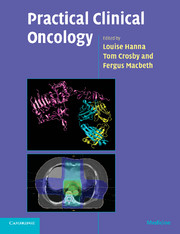Book contents
- Frontmatter
- Contents
- List of contributors
- Preface
- Acknowledgements
- Abbreviations
- 1 Practical issues in cytotoxic chemotherapy usage
- 2 Biological treatments in cancer
- 3 Hormones in cancer
- 4 Radiotherapy planning
- 5 Research in cancer
- 6 Oncological emergencies
- 7 Palliative care
- 8 Head and neck
- 9 Oesophagus
- 10 Stomach
- 11 Liver, gallbladder and biliary tract
- 12 Exocrine pancreas
- 13 Colon and rectum
- 14 Anus
- 15 Gastrointestinal stromal tumours
- 16 Breast
- 17 Kidney
- 18 Bladder
- 19 Prostate
- 20 Testis
- 21 Penis
- 22 Ovary
- 23 Body of the uterus
- 24 Cervix
- 25 Vagina
- 26 Vulva
- 27 Gestational trophoblast tumours
- 28 Lung
- 29 Mesothelioma
- 30 Soft tissue and bone tumours in adults
- 31 The lymphomas and myeloma
- 32 Central nervous system
- 33 Skin cancer other than melanoma
- 34 Melanoma
- 35 Thyroid
- 36 Neuroendocrine tumours
- 37 Cancer in children
- 38 Cancer of unknown primary
- 39 The use of radiotherapy in the treatment of benign conditions
- Multiple choice questions
- Multiple choice answers
- Index
- References
11 - Liver, gallbladder and biliary tract
Published online by Cambridge University Press: 23 December 2009
- Frontmatter
- Contents
- List of contributors
- Preface
- Acknowledgements
- Abbreviations
- 1 Practical issues in cytotoxic chemotherapy usage
- 2 Biological treatments in cancer
- 3 Hormones in cancer
- 4 Radiotherapy planning
- 5 Research in cancer
- 6 Oncological emergencies
- 7 Palliative care
- 8 Head and neck
- 9 Oesophagus
- 10 Stomach
- 11 Liver, gallbladder and biliary tract
- 12 Exocrine pancreas
- 13 Colon and rectum
- 14 Anus
- 15 Gastrointestinal stromal tumours
- 16 Breast
- 17 Kidney
- 18 Bladder
- 19 Prostate
- 20 Testis
- 21 Penis
- 22 Ovary
- 23 Body of the uterus
- 24 Cervix
- 25 Vagina
- 26 Vulva
- 27 Gestational trophoblast tumours
- 28 Lung
- 29 Mesothelioma
- 30 Soft tissue and bone tumours in adults
- 31 The lymphomas and myeloma
- 32 Central nervous system
- 33 Skin cancer other than melanoma
- 34 Melanoma
- 35 Thyroid
- 36 Neuroendocrine tumours
- 37 Cancer in children
- 38 Cancer of unknown primary
- 39 The use of radiotherapy in the treatment of benign conditions
- Multiple choice questions
- Multiple choice answers
- Index
- References
Summary
Introduction
Primary liver cancer is one of the most common cancers worldwide, and it predominantly affects people in developing countries. It is often associated with chronic liver infections and it is more common in males. Patients usually present with advanced disease and treatment options are influenced, and often limited, by co-morbidities, especially poor function of the rest of the liver.
Tumours of the gallbladder and biliary tract are relatively rare. Patients often present late with symptoms of biliary obstruction which, together with cholangitis, is a common cause of morbidity and death and is the main target for palliative therapies. Gallbladder and biliary tract tumours are moderately chemosensitive. Cytological or histological confirmation of disease is often difficult, and specialist multidisciplinary teams of expert radiologists and pathologists should be involved in the diagnosis and staging. Radical surgery should only be carried out by tertiary surgical teams, and patients should be managed, whenever possible, within clinical trials.
Tumours of the liver
The types of tumour that affect the liver are shown in Table 11.1.
Anatomy of the liver
The liver is divided into right and left lobes by the falciform ligament, but more importantly, in terms of surgical resection, a segmental division can be made and seen with imaging based on the relationship to the hepatic and portal veins. There are four segments in both the left and the right liver.
- Type
- Chapter
- Information
- Practical Clinical Oncology , pp. 141 - 150Publisher: Cambridge University PressPrint publication year: 2008



